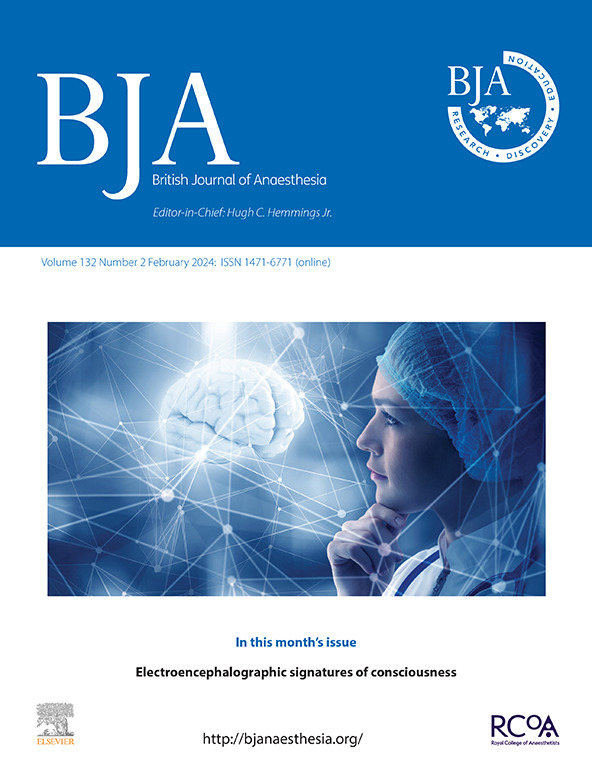异氟醚直接抑制半胱硫氨酸-β-合成酶有助于小鼠异氟醚全身麻醉后延迟神经认知恢复。
IF 9.2
1区 医学
Q1 ANESTHESIOLOGY
引用次数: 0
摘要
背景:围手术期神经认知障碍(PND)是外科手术和其他侵入性手术的严重并发症。然而,全身麻醉导致PND的潜在机制在很大程度上仍然未知。基于高同型半胱氨酸血症与PND风险增加之间的联系,我们研究了全身麻醉后胱硫氨酸-β-合成酶(CBS)的功能改变及其在记忆功能中的作用。方法:小鼠经1.4 vol%异氟醚麻醉2 h,采用ELISA法测定小鼠血清同型半胱氨酸水平、同型半胱氨酸相关酶表达及CBS活性。采用情境恐惧条件反射试验评价全麻后记忆重建的时间过程。使用WaterLOGSY来检查异氟醚与CBS之间的相互作用。使用硫化氢(H2S)探针AZ-NO2进行H2S生物成像,并进行RNA测序,亚硫酸盐检测和体内电生理记录以探索潜在的机制。结果:异氟醚麻醉后认知功能下降持续至少8小时,这是由于异氟醚通过直接抑制CBS活性选择性地在大脑中积累同型半胱氨酸。CBS的激活减轻了H2S的减少,改变了突触相关蛋白的巯基化,最终加速了海马神经元放电率的恢复(生理盐水,1.42 [0.49]vs NaHS, 2.45 [0.68] Hz)。s -腺苷蛋氨酸(SAM, CBS激活剂)预处理可延长异氟醚麻醉后小鼠的冷冻时间(对照组4.86[3.30]%,对照组9.89[3.03]%)。结论:异氟醚通过直接抑制CBS活性,延迟小鼠在异氟醚麻醉后的认知恢复,为异氟醚参与pnd及其潜在机制提供了新的见解。本文章由计算机程序翻译,如有差异,请以英文原文为准。
Direct inhibition of cystathionine-β-synthase by isoflurane contributes to delayed neurocognitive recovery after isoflurane general anaesthesia in mice
Background
Perioperative neurocognitive disorders (PND) are severe complications of surgery and other invasive procedures. However, the underlying mechanisms by which general anaesthetics contribute to PND remain largely unknown. Based on our findings of a link between hyperhomocysteinaemia and increased risk of PND, we investigated functional alterations in cystathionine-β-synthase (CBS) and its role in memory function after general anaesthesia.
Methods
Mice were subjected to isoflurane 1.4 vol% anaesthesia for 2 h, and the levels of homocysteine, homocysteine-associated enzyme expression, and CBS activity were measured using ELISA. The time course of memory reconstruction after general anaesthesia was evaluated using the contextual fear conditioning test. WaterLOGSY was used to examine the interaction between isoflurane and CBS. A hydrogen sulfide (H2S) probe, AZ-NO2, was used for H2S bioimaging, and RNA sequencing, sulfhydrome detection, and in vivo electrophysiological recordings were performed to explore the underlying mechanisms.
Results
The decline in cognitive function persisted for at least 8 h after isoflurane anaesthesia, which is attributed to the selective homocysteine accumulation in the brain via direct inhibition of CBS activity by isoflurane. Activation of CBS alleviates the reduction of H2S and alters the sulfhydration of synaptic-related proteins, ultimately accelerating the restoration of neuronal firing rates in the hippocampus (saline, 1.42 [0.49] vs NaHS, 2.45 [0.68] Hz). Pretreatment with S-adenosylmethionine (SAM, CBS activator) could increase the freezing time of mice after isoflurane anaesthesia (control 4.86 [3.30]% vs SAM, 9.89 [3.03]%).
Conclusions
Isoflurane contributes to delayed cognitive recovery after isoflurane anaesthesia in mice by directly inhibiting CBS activity, providing novel insights into the involvement of isoflurane in PNDs and their underlying mechanisms.
求助全文
通过发布文献求助,成功后即可免费获取论文全文。
去求助
来源期刊
CiteScore
13.50
自引率
7.10%
发文量
488
审稿时长
27 days
期刊介绍:
The British Journal of Anaesthesia (BJA) is a prestigious publication that covers a wide range of topics in anaesthesia, critical care medicine, pain medicine, and perioperative medicine. It aims to disseminate high-impact original research, spanning fundamental, translational, and clinical sciences, as well as clinical practice, technology, education, and training. Additionally, the journal features review articles, notable case reports, correspondence, and special articles that appeal to a broader audience.
The BJA is proudly associated with The Royal College of Anaesthetists, The College of Anaesthesiologists of Ireland, and The Hong Kong College of Anaesthesiologists. This partnership provides members of these esteemed institutions with access to not only the BJA but also its sister publication, BJA Education. It is essential to note that both journals maintain their editorial independence.
Overall, the BJA offers a diverse and comprehensive platform for anaesthetists, critical care physicians, pain specialists, and perioperative medicine practitioners to contribute and stay updated with the latest advancements in their respective fields.

 求助内容:
求助内容: 应助结果提醒方式:
应助结果提醒方式:


